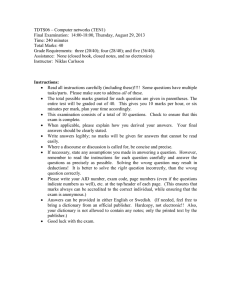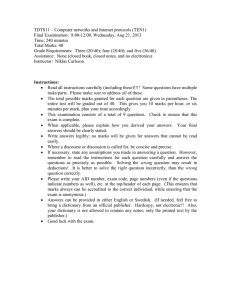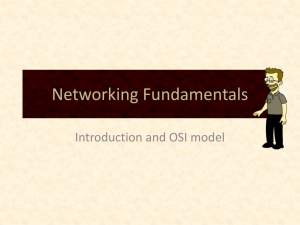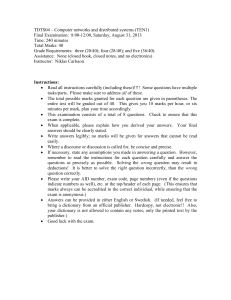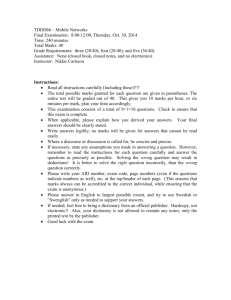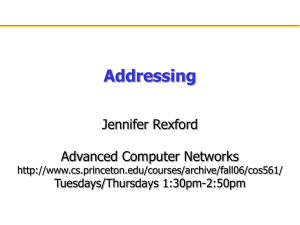TDTS11 – Computer networks and Internet protocols (TEN1)
advertisement
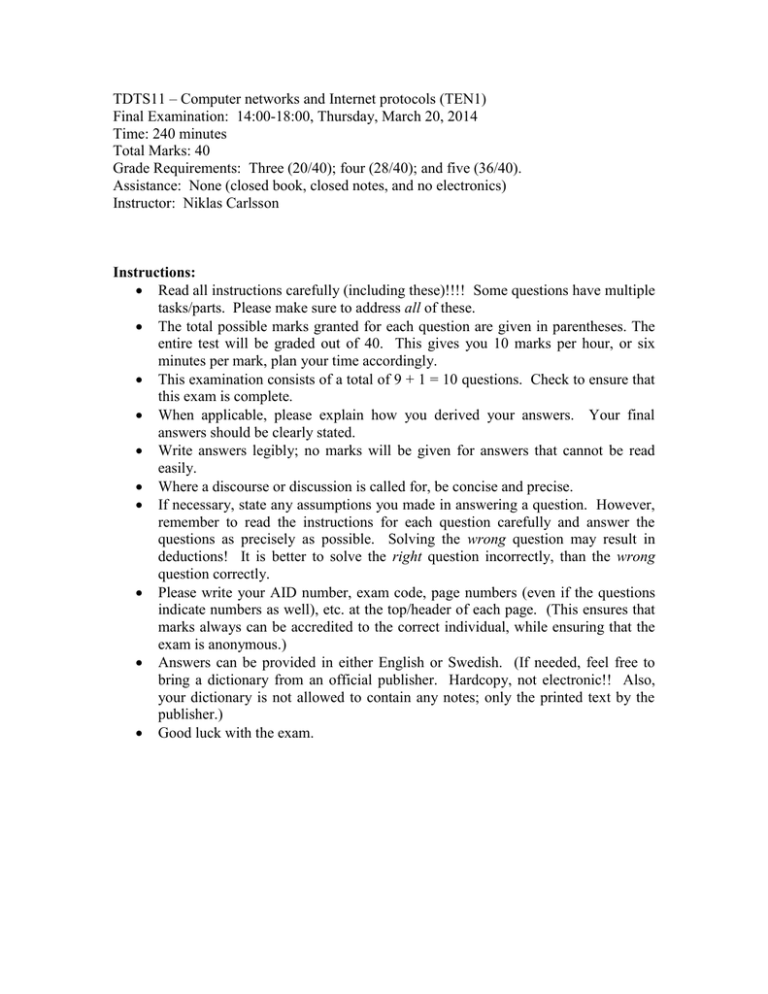
TDTS11 – Computer networks and Internet protocols (TEN1) Final Examination: 14:00-18:00, Thursday, March 20, 2014 Time: 240 minutes Total Marks: 40 Grade Requirements: Three (20/40); four (28/40); and five (36/40). Assistance: None (closed book, closed notes, and no electronics) Instructor: Niklas Carlsson Instructions: Read all instructions carefully (including these)!!!! Some questions have multiple tasks/parts. Please make sure to address all of these. The total possible marks granted for each question are given in parentheses. The entire test will be graded out of 40. This gives you 10 marks per hour, or six minutes per mark, plan your time accordingly. This examination consists of a total of 9 + 1 = 10 questions. Check to ensure that this exam is complete. When applicable, please explain how you derived your answers. Your final answers should be clearly stated. Write answers legibly; no marks will be given for answers that cannot be read easily. Where a discourse or discussion is called for, be concise and precise. If necessary, state any assumptions you made in answering a question. However, remember to read the instructions for each question carefully and answer the questions as precisely as possible. Solving the wrong question may result in deductions! It is better to solve the right question incorrectly, than the wrong question correctly. Please write your AID number, exam code, page numbers (even if the questions indicate numbers as well), etc. at the top/header of each page. (This ensures that marks always can be accredited to the correct individual, while ensuring that the exam is anonymous.) Answers can be provided in either English or Swedish. (If needed, feel free to bring a dictionary from an official publisher. Hardcopy, not electronic!! Also, your dictionary is not allowed to contain any notes; only the printed text by the publisher.) Good luck with the exam. TDTS11 – Computer networks and Internet protocols Final Exam: 14:00-18:00, Thursday, March 20, 2014 1) Question: Forwarding (6) Show, illustrate, and explain the path of (i) the first HTTP request and (ii) the first HTTP response between a Web client (browser) and a Web server. You can make the following assumptions: The client is located in Sweden and the server in USA. The client machine uses Ethernet, has a single interface with a MAC address AA:AA:AA:AA:AA:AA. The GET request is for a webpage: www.aa.com/index.html. The client has obtained a dynamic IP address 111.222.111.222 from a DHCP server, which is running on the closest gateway router. The client uses a local DNS server with IP address 111.222.1.1 and MAC address EE.EE.EE.EE.EE.EE. The MAC and IP addresses of the Web server are DD:DD:DD:DD:DD:DD and 196.222.111.111. Similar to the client, the server has a single interface. The gateway router closest to the client has four interfaces. The first is the interface closest to the client and has MAC and IP addresses BB:BB:BB:BB:BB:AA and 111.222.111.1. The second interface has MAC and IP addresses BB:BB:BB:BB:BB:BB and 111.222.111.2. The third interface has MAC and IP addresses BB:BB:BB:BB:BB:CC and 111.222.111.3. Finally, the fourth interface has MAC and IP addresses BB:BB:BB:BB:BB:DD and 111.222.111.4. The gateway router closest to the server has four interfaces. The first is the interface closest to the server and has MAC and IP addresses CC:CC:CC:CC:CC:AA and 196.222.111.1. The second interface has MAC and IP addresses CC:CC:CC:CC:CC:BB and 196.222.111.2. The third interface has MAC and IP addresses CC:CC:CC:CC:CC:CC and 196.222.111.3. Finally, the fourth interface has MAC and IP addresses CC:CC:CC:CC:CC:DD and 196.222.111.4. The forwarding table at the gateway router closest to the client has many entries. However, for this question, the four most closely related entries for each interface states 196.222.0.0/18 over interface 2, 196.222.110.0/23 over interface 3, 196.222.110.0/24 over interface 4, and 196.222.64.0/18 over interface 2. The forwarding table at the gateway router closest to the server has many entries. However, for this question, the four most closely related entries for each interface states 111.222.192.0/18 over interface 2, 111.222.0.0/18 over interface 3, 111.222.64.0/18 over interface 4, and 111.222.0.0/24 over interface 2. For this question you should also draw a picture of the topology, clearly indicate the path taken by the packet in this topology, and clearly state any assumptions you make about the topology (including parts of the networks not explained above) or anything else needed to solve the question. As with all your answers it is important that you also explain how you derived your answer. For example, why was the packet taking this particular route and not some other route? 2 TDTS11 – Computer networks and Internet protocols Final Exam: 14:00-18:00, Thursday, March 20, 2014 2) Question: Encapsulation (4) Consider the same scenario as above (Q1). Please use a figure to show and illustrate the link-layer frame and encapsulated information for the first HTTP request message when it reaches the first traversed network interface card (link layer) of the gateway router closest to the server. You do not have to show all the details of the different headers; however, you should provide a figure that clearly (i) specify what protocols the different headers are associated with, and (ii) provide the address information associated with the source and destination fields for each of the different headers contained within this frame. 3) Question: DHCP, ARP and DNS (4) Consider the same scenario as above (Q1+Q2). Please use a figure to show and explain (i) the sequence of packets, and (ii) their corresponding header information that were used by the client to obtain all the IP and MAC addresses that it uses when sending the HTTP GET request to the Web server. Please use a figure that clearly shows the timeline and indicates what address information is included in each of these messages. Your figure should include protocol and message information for how the following protocols are used: Dynamic Host Configuration Protocol (DHCP), Address Resolution Protocol (ARP), and Domain Name System (DNS). 4) Question: TCP slow start (4) Consider the download of the above file index.html, located on www.aa.com. Assume that the client and server are using non-persistent HTTP/1.0, and that there is a 200ms round trip time (RTT) between them. Draw a figure and explain the entire communication sequence associated with the file download, including the TCP handshake and connection teardown. You can assume that the payload is 20 packets, each packet can be sent in 1ms, and that the ninth (9) payload packet is lost. For simplicity, you can assume that the TCP version is implementing fast retransmit, initially have ssthresh = 4, and the timeout period is (approximately) constant at 500ms. You should include a figure that clearly show when each packet is sent and received. 5) Question: HTTP and replication (6) Performance and personalized service are important aspects of building good Web services. To improve performance when downloading multiple objects from the same server, persistent connections and parallelism can be used. Please draw a picture illustrating the communication sequence when the client above downloads the Web page www.aa.com/index.html and three embedded images. You can also assume that both the servers and the client can use up-to five parallel persistent connections, but neither the client nor the servers allow pipelining. (In other words, your solution is expected to use persistent connections without pipelining.) The main document and one of the embedded images can be found on the original Web server www.aa.com and the final two embedded images can be found on the server www.bb.com. Your picture should illustrate the client, its local DNS server, all involved Web servers, and the communication sequence. Your picture should also clearly show connection establishment and teardown messages, as 3 TDTS11 – Computer networks and Internet protocols Final Exam: 14:00-18:00, Thursday, March 20, 2014 well as any other messages needed for the file transfer. You can assume that the HTML page and each of the images are 5KB each, the MSS is 1.5KB, and both the contacted servers for the websites www.aa.com and www.bb.com have the same RTT and loss rates to the client. Also, how many packets are being sent between each of the two servers and the client? Which of the two servers is likely to be active for the longest period of time? 6) Caching and end-to-end delay (6) HTTP caches play an important role in networks. Assume that the ISP of the client above (e.g., Q1) has installed a cache in its network. Assume that the RTT to the cache is 5ms and the RTT to the server www.aa.com is 200ms. Furthermore, assume that the average client in the ISPs network have an average RTT of 150ms to a representative sample set of Webpages that these clients access. Estimate how much improvement in the download time you will obtain at a cache hit of www.aa.com/index.html (i.e., when downloading the content from the cache instead of from the server). Estimate how much improvement in the average RTT the average client in the ISPs network will see after such installation. For this question you can assume that after the initial warm-up period (when the cache initially is empty) the cache will see an average hit rate of 40%. How much bandwidth will the cache help the ISP to save? In addition to the above assumptions about the overall hit rate, please consider two cases. First assume that the hit rate of all file sizes is the same. Second, and perhaps more realistically, assume that the hit rate is smaller for large files than small files. 7) Question: Distance vector routing (4) Consider a node A with neighbors B, C, and D. Node A currently has the distance table below. (Note that the network currently is not in a very good shape, and a few routing table updates will be needed to get the network back into shape.) Assume that it receives an updated distance vector from neighbor B which looks as follows [∞, 0, 2, 7, 5, 9, 3] and an updated distance vector from neighbor C which looks as follows [∞, 3, 0, 4, 2, 3, 5] . First, update the table below, including A’s own distance vector. Second, assume that poison reverse is implemented, and show and explain exactly what information the node sends to each its neighbors (after the table has been updated). Destination A B C D E F G A (via) 0 (A) 1 (B) 1 (C) 1 (D) ? (?) ? (?) ? (?) Costs B C D ∞ ∞ ∞ 0 2 4 8 4 12 4 0 4 5 13 9 2 7 0 4 9 7 4 TDTS11 – Computer networks and Internet protocols Final Exam: 14:00-18:00, Thursday, March 20, 2014 8) Question: Packet losses and UDP-based streaming (2) Give a concrete example how interleaving can be used to handle packet losses in video streaming? Please use a figure to illustrate. 9) BGP routing (4) Consider the following information visible to a Border Gateway Protocol (BGP) router in an Autonomous System (AS) A. There are four neighboring ASes: B, C, D, and E. AS A’s internal path costs to the closest gateway routers of each of these three ASes are 2, 3, 5, and 7, respectively. A is a customer of B and C; A is peering with D and E. For prefix 11.22.0.0/20 AS A sees the following route announcements: B Y Z; C F Z; D Q P Z; and E R Z. The last web request that a client located within AS A did to a server located in AS B, C, D, E had a RTT of 25ms, 35ms, 45ms, and 55ms, respectively. The last traceroute that somebody in AS B performed to a server or router in AS Z required 13 router hops. The corresponding numbers for traceroute queries between ASes C-Z, D-Z, and E-Z are 12, 15, and 14, respectively. Please (i) draw a picture of the topology, as seen by AS A, (ii) show and carefully explain how the particular entry for the above prefix would look in the router’s forwarding table, and (iii) clearly list and order the information that is being used when determining this routing table entry. Note that the order should clearly reflect the priority (and order) used in making the routing decision (and similar routing decisions). 10) Bonus question: IP fragmentation (4) Consider a 4,000 byte IPv4 datagram which traverses 10 links on its path from A to B. Assume that links 1, 2, 5 and 7 have a maximum transmission unit (MTU) of 5,000 bytes and the other links have an MTU of 1,500 bytes. (a) Please use a figure and explain when fragmentations occurs, and into how many fragments the datagram is fragmented/defragmented as it traverses each link of the forwarding path from A to B. (b) Please use a figure and explain how this scenario will change if all routers on the path used IPv6. You can assume that the MTUs are the same as for the IPv4 case. Good luck!! 5
